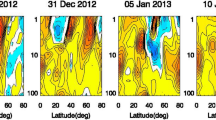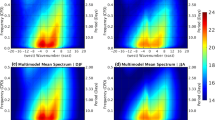Summary
The role of stationary (monthly mean) and transient (departure from monthly mean) waves within the atmospheric energy cycle is examined using global analyses from the European Centre for Medium Range Weather Forecasts (ECMWF) for the period 1980–1987. Only January and July averages are considered.
It is confirmed that planetary stationary waves are basically baroclinic. Their contribution to the globally averaged energy cycle of the atmosphere is comparable to that of the transient waves. In January they contribute about 40% to the baroclinic conversion (CA) from zonal mean to eddy available potential energy. Local values for the northern hemisphere even show a predominant role of the stationary wave conversions over those originating from transient waves. Part of the available potential energy of stationary waves (A SE) is converted to kinetic energy by warm air rising and cold air sinking. Nonlinear energy conversion, which can be interpreted as destruction of stationary temperature waves by transients, is the second sink forA SE. The order of magnitude of these two processes is similar.
Barotropic nonlinear conversions, though negligible in the global average, reveal large conversion rates between the mean positions of the polar and the subtropical jets. Their orientation is suggestive of a tendency to increase stationary wave kinetic energyK SE at its local minimum between the jets at the expense of the synoptic scale transients.
While all terms of the energy cycle related to stationary waves reveal a predominance of the planetary scale (zonal wave numbers 1–3) transient waves are governed by synoptic scale waves (zonal wave numbers 4–9) only with respect to the baroclinic and barotropic conversions: a significant amount of transient wave energy (50% for the global average ofA TE) is due to planetary scale waves.
Similar content being viewed by others
References
Arpe, K., Brancovic, C., Oriol, E., Speth, P., 1986: Variability in time and space of energetics from a long series of atmospheric data produced by ECMWF.Beitr. Phys. Atmos.,59, 321–363.
Baker, W. E., Brin, Y., 1985: A comparison of observed and forecast energetics over North America.Quart. J. Roy. Meteor. Soc.,111, 641–655.
Blackmon, M. L., Branstator, G. W., Bates, G. T., Geisler, J. E., 1987: An analysis of equatorial Pacific sea surface temperature anomaly experiments in general circulation models with and without mountains.J. Atmos. Sci.,44, 1828–1844.
Chen, T.-C., 1982: A further study of spectral energetics in the winter atmosphere.Mon. Wea. Rev.,110, 947–961.
Fleming, E. L., Lim, G.-H., Wallace, J. M., 1987: Differences between the spring and autumn circulation of the Northern Hemisphere.J. Atmos. Sci.,44, 1266–1286.
Galin, M. B., Kirichkov, S. Y., 1986: Energetics of circulation states in a model including orography.Izvestiya, Atmospheric and Oceanic Physics,22, 613–619.
Hansen, A. R., Sutera, A., 1984: A comparison of the spectral energy and enstrophy budgets of blocking versus non-blocking periods.Tellus,36A, 52–63.
Hayashi, Y., Golder, D. G., 1983: Transient planetary waves simulated by GFDL spectral general circulation models. Part I: Effects of mountains.J. Atmos. Sci.,40, 941–950.
Heckley, W. A., 1985: Systematic errors of the ECMWF operational forecasting model in tropical regions.Quart. J. Roy. Meteor. Soc.,111, 709–738.
Heckley, W. A., Gill, A. E., 1984: Some simple analytical solutions to the problem of forced equatorial long waves.Quart. J. Roy. Meteor. Soc.,110, 203–217.
Held, I. M., 1983: Stationary and quasi-stationary eddies in the extratropical troposphere: theory. In: Hoskins, B. J., Pearce, R. P. (ed.)Large-scale dynamical processes in the atmosphere, London: Academic Press, pp. 127–168.
Held, I. M., Hoskins, B. J. 1985: Large-scale eddies and the general circulation of the troposphere. In: Manabe, S. (ed.)Advances in geophysics 28A, Issues in atmospheric and oceanic modeling. Climate Dynamics, Orlando: Academic Press, pp. 3–31.
Holopainen, E. O., 1970: An observational study of the energy balance of the stationary disturbances in the atmosphere.Quart. J. Roy. Meteor. Soc.,96, 626–644.
Holopainen, E., Fortelius, C., 1987: High-frequency transient eddies and blocking.J. Atmos. Sci.,44, 1632–1645.
Holopainen, E., Fortelius, C., Ruosteenoja, K., 1988: The effect of transient eddies on the stationary eddy isobaric height field.J. Atmos. Sci.,45, 1760–1769.
Hoskins, B. J., James, I. N., White, G. H., 1983: The shape, propagation and mean-flow interaction of large-scale weather systems.J. Atmos. Sci.,40, 1595–1612.
Huang, H.-J., Vincent D. G., 1985: Significance of the South Pacific convergence zone in energy conversions of the southern hemisphere during FGGE, 10–27 January 1979.Mon. Wea. Rev.,113, 1359–1371.
Huang, H.-J., Vincent, D. G., 1988: Daily spectral energy conversions of the global circulation during 10–27 January 1979.Tellus,40 A, 37–49.
Jacqmin, D., Lindzen, R. S., 1985: The causation and sensitivity of the northern winter planetary waves.J. Atmos. Sci.,42, 724–745.
Kung, E. C., 1988: Spectral energetics of the general circulation and time spectra of transient waves during the FGGE year.J. Climate,1, 5–19.
Kung, E. C., Baker, W. E., 1986: Spectral energetics of the observed and simulated northern hemisphere general circulation during blocking episodes.J. Atmos. Sci.,43, 2792–2812.
Kung, E. C., Masters, S. E., Corte-Real, J. A. M., 1983: Large-scale energy transformations in the high latitudes of the northern hemisphere.J. Atmos. Sci.,40, 1061–1072.
Kung, E. C., Tanaka, H., 1983: Energetics analysis of the global circulation during the Special Observation Periods of FGGE.J. Atmos. Sci.,40, 2575–2592.
Kushnir, Y., Esbensen, S. K., 1986: Northern hemisphere wintertime variability in a two-level general circulation model. Part II: The maintenance of short and long time-scale disturbances.J. Atmos. Sci.,43, 2985–2998.
Lambert, S. J., 1987: Spectral energetics of the Canadian climate centre general circulation model.Mon. Wea. Rev.,115, 1295–1305.
Lau, N.-C., Oort, A. H., 1982: A comparative study of observed northern hemisphere circulation statistics based on GFDL and NMC analyses. Part II: Transient eddy statistics and the energy cycle.Mon. Wea. Rev.,110, 889–906.
Van Loon, H., 1979: The association between latitudinal temperature gradient and eddy transport. Part I: Transport of sensible heat in winter.Mon. Wea. Rev.,107, 525–534.
Lorenz, N. L., 1955: Available potential energy and the maintenance of the general circulation.Tellus,7, 157–167.
Metz, W., 1986: Transient cyclone-scale vorticity forcing of blocking highs.J. Atmos. Sci.,43, 1467–1483.
Nigam, S., Held, I. M., Lyons, S. W., 1986: Linear simulation of stationary eddies in a general circulation model. Part I: The no-mountain model.J. Atmos. Sci.,43, 2944–2961.
Oort, A. H., 1964: On estimates of the atmospheric energy cycle.Mon. Wea. Rev.,92, 483–493.
Opsteegh, J. D., Vernekar, A. D., 1982: A simulation of the January standing wave pattern including the effects of transient eddies.J. Atmos. Sci.,39, 734–744.
Oriol, E., 1982: Energy budget calculations at ECMWF. Part I: Analyses 1980–1981. ECMWF Tech. Rep. No. 35, 114 pp.
Ponater, M., 1985: Räumlich-zeitliche Entwicklung energetischer Parameter während blockierender Wetterlagen. Mitteilungen aus dem Institut für Geophysik und Meteorologie der Universität zu Köln, Heft 46.
Ponater, M., Frenzen, G., 1987: On the numerical evaluation of the energy conversion integral.Tellus,39 A, 515–520.
Randel, W. J., Stanford, J. L., 1985a: An observational study of medium-scale wave dynamics in the Southern Hemisphere summer. Part I: Wave structure and energetics.J. Atmos. Sci.,42, 1172–1188.
Randel, W. J., Stanford, J. L., 1985b: The observed life cycle of a baroclinic instability.J. Atmos. Sci.,42, 1364–1373.
Rosen, R. D., Salstein, D. A., 1982: General circulation statistics on short time scales.Mon. Wea. Rev.,110, 683–689.
Rosen, R. D., Salstein, D. A., Peixoto, J. P., Oort, A. H., Lau, N.-C., 1985: Circulation statistics derived from level III-b and station-based analyses during FGGE.Mon. Wea. Rev.,113, 65–88.
Rosen, R. D., Salstein, D. A., Miller, A. J., Arpe, K., 1987: Accuracy of atmospheric angular momentum estimates from operational analyses.Mon. Wea. Rev.,115, 1627–1639.
Sheng, J., Derome, J., 1989: Observed and simulated energy cycles in the frequency domain. IAMAP 89 Abstracts Vol.II, ND 17.
Simmons, A. J., 1982: The forcing of stationary wave motion by tropical diabatic heating.Quart. J. Roy. Meteor. Soc.,108, 503–534.
Simmons, A. J., Hoskins, B. J., 1978: The life cycles of some nonlinear baroclinic waves.J. Atmos. Sci.,35, 414–432.
Simmons, A. J., Hoskins, B. J., 1980: Barotropic influences on the growth and decay of nonlinear baroclinic waves.J. Atmos. Sci.,37, 1679–1684.
Stein, C., 1986: Das zeitliche Zusammenwirken barokliner Energieumwandlungen durch großräumige Wellen in der Atmosphäre. Diplomarbeit, Institut für Geophysik und Meteorologie der Universität zu Köln.
Stone, P. H., 1978: Baroclinic adjustment.J. Atmos. Sci.,35, 561–571.
Trenberth, K. E., 1987: The role of eddies in maintaining the westerlies in the southern hemisphere winter.J. Atmos. Sci.,44, 1498–1508.
Trenberth, K. E., Olson, J. G., 1988 a: ECMWF global analyses 1979–1986: Circulation statistics and data evaluation. NCAR Tech. Note NCAR/TN-300 + STR. 94 pp.
Trenberth, K. E., Olson, J. G., 1988 b: Intercomparison of NMC and ECMWF global analyses 1980–1986. NCAR Tech. Note NCAR/TN-301 + STR. 81 pp.
Trenberth, K. E., Olson, J. G., 1988c: An evaluation and intercomparison of global analyses from the National Meteorological Center and the European Center for Medium Range Weather Forecasts.Bull. Amer. Meteor. Soc.,69, 1047–1057.
Wallace, J. M., 1983: The climatological mean stationary waves: observational evidence. In: Hoskins, B. J., Pearce, R. P. (ed.) Large-scale dynamical processes in the atmosphere, London: Academic Press, pp. 27–53.
Wallace, J. M., Lau, N.-C., 1985: On the role of barotropic energy conversions in the general circulation. In: Manabe, S. (ed.)Advances in geophysics,28 A, Issues in atmospheric and oceanic modeling, Climate Dynamics, Orlando: Academic Press, pp. 33–74.
White, G. H., 1982: An observational study of the Northern Hemisphere extratropical summertime general circulation.J. Atmos. Sci.,39, 24–40.
Author information
Authors and Affiliations
Additional information
With 15 Figures
Rights and permissions
About this article
Cite this article
Ulbrich, U., Speth, P. The global energy cycle of stationary and transient atmospheric waves: Results from ECMWF analyses. Meteorl. Atmos. Phys. 45, 125–138 (1991). https://doi.org/10.1007/BF01029650
Received:
Revised:
Issue Date:
DOI: https://doi.org/10.1007/BF01029650




